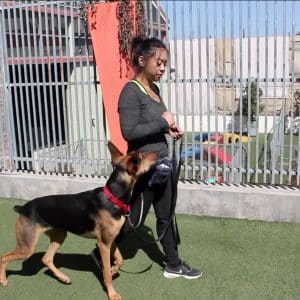This is a guest blog by April. In addition to being one of the managers at the Main Campground’s Front Desk, April coordinates Pet Camp’s Camper Cadet Program where your dog can learn all the necessary manners to succeed as an urban dog.
The first week of October is National Walk your Dog week! A wonderful campaign that was founded in 2010 by Colleen Paige, a Pet Lifestyle Expert and Animal Advocate who desperately wanted to bring awareness to the canine behavior and obesity problem in America. Here at Pet Camp, we completely agree that spending valuable time exercising you and your pooch is fantastic and worth being celebrated! It will not only benefit your pet’s health, but your own as well.
Our blog has great information and if you want to see these tips in action take a look at our video!
We understand that getting up and motivated to take a walk can be difficult if your dog’s leash manners are something to be desired. We’re all too aware of that anxiety that builds up when you reach for the leash and you’re instantly flooded with reminders of why you don’t take walks with your dog more often. The pulling, the reacting to other dogs and squirrels, the sore shoulder you’re left with when you finally manage to stumble back home after an experience that was definitely no walk in the park. So we here at Pet Camp would love to offer you a few tips as well as a compassionate “we’ve been there”.
I
Dogs love a schedule so they know what to expect. Make the walk a pattern while you’re starting out; everything from the place you hang the leash, to the route you take and the treats you use. We recommend your dog’s favorite treats be used for this training and only given to your dog during the walk so that they look forward to it. Start training at the front door. Get your dog’s attention on you and the treat. Take short strides, treating your pet frequently at first for staying beside you and looking up at you. Increase the length of your stride and how often you treat little by little. Stop and get your dog’s attention back on you every time they try to pull ahead. Part of the reward with loose leash training is moving forward. Treat and praise when your dog ignores distractions and focuses on you. When you’ve got the patterned route down, venture out to new areas.
We’ll be honest, starting out is going to be the hardest part. Every time you start to feel yourself get frustrated, take a break. Lots of short training sessions are actually more effective than a few long ones. But don’t take too long of a break! Even a few days between training sessions will ruin progress.
It may take a while, but in the end, we promise it’s worth it. A dog that behaves on the leash will make you want to get up and go outside more. You’ll find an exercised pooch behaves better in other training areas and lets you relax at home. You will also find you feel less guilty about having that extra slice of pizza if you and Fido had your morning stroll. And if you’re having trouble or have hit a snag in training, pop down to Pet Camp’s Main Campground and ask about our Camper Cadet program! Our trainers would love to help set you up with a starting point and offer more tips and sessions. Your dog will thank you for all the extra walks!
Thanks for reading.
